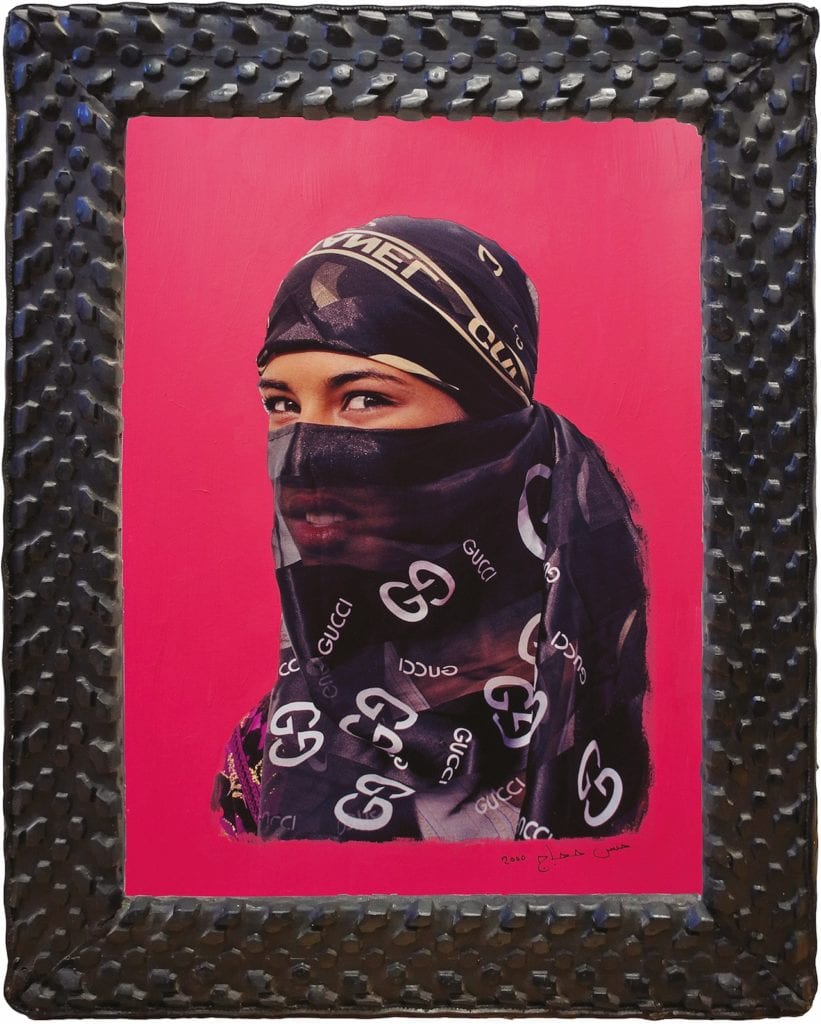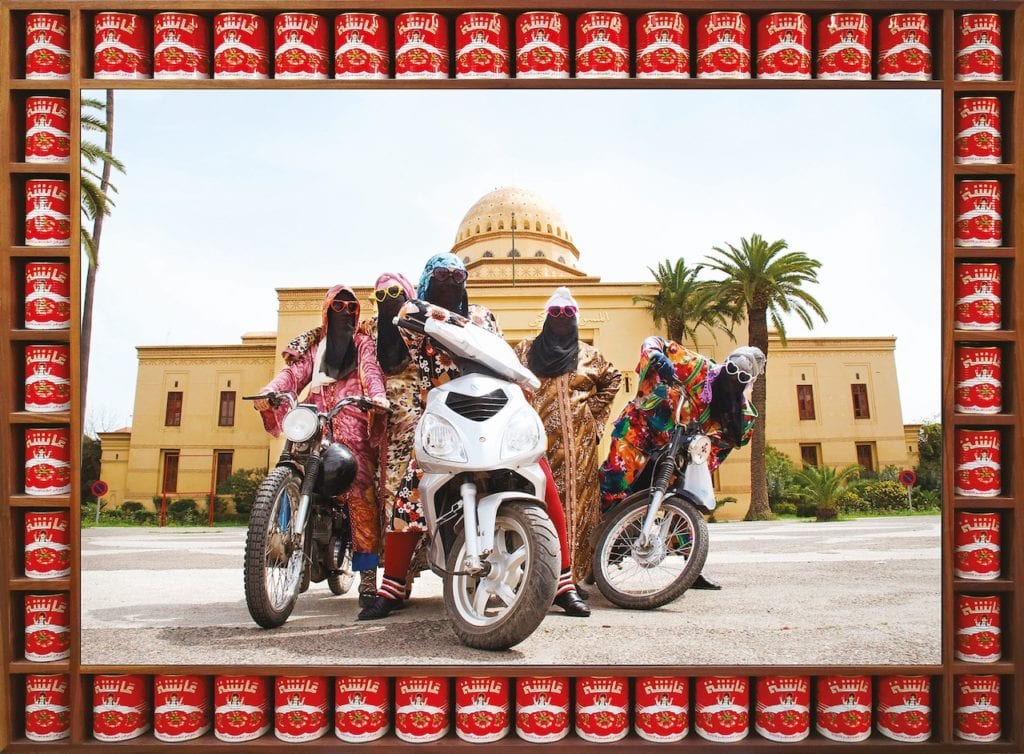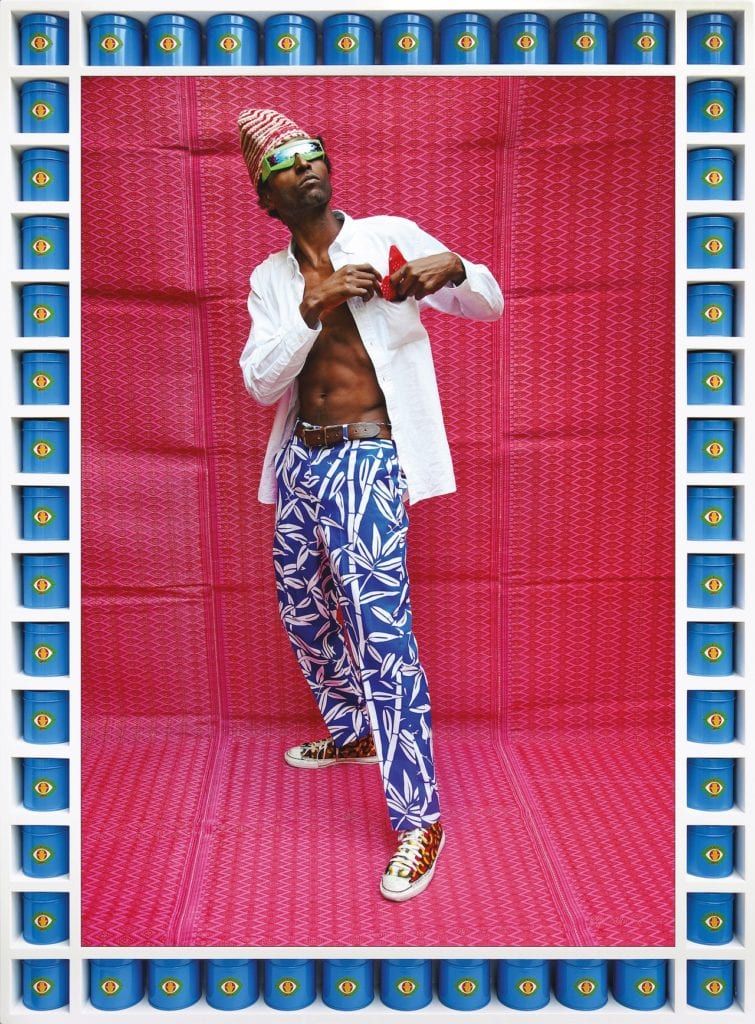This article was published in issue #7888 of British Journal of Photography. Visit the BJP Shop to purchase the magazine here.
This autumn, Hassan Hajjaj is taking over the Maison Européenne de la Photographie in Paris, having been given carte blanche to create a solo exhibition. “Because it’s called Maison, I wanted to treat it as my home, and because I’m Moroccan, we’re calling it Maison Marocaine,” he says, explaining that his photographs, video works, sculptural installations and clothing will be presented alongside wallpapers, rugs and furniture. Even the bookshop will be turned into a boutique selling artworks, fashion, bags, books, lamps and ceramics.
Although the exhibition is Hajjaj’s first major one in France, he is in familiar territory, having designed the former interior of the celebrated Andy Wahloo bar near the Centre Pompidou with low Moroccan-style furniture and fabrics. Andy Wahloo (wahloo meaning ‘I have nothing’ in Arabic) is the nickname that the late French-Algerian singer Rachid Taha gave Hajjaj, and is printed, like a trademark, on his clothes. It also alludes to how he combines Pop Art aesthetics with North African culture, and is a spin on him being dubbed the ‘Andy Warhol of Marrakech’.

Malicious Look, from the series Handpainted Portraits, 2000. © Hassan Hajjaj.
This tendency to borrow and blend ideas, from ethnic influences to fashion logos, and to explore questions about cultural appropriation and identity politics in an exuberant, playful way, will reverberate throughout the exhibition. Yet the first room greeting visitors contains not Hajjaj’s work but that of Zahrin Kahlo and Lamia Naji. “I was asked [by the MEP] to invite female Moroccan photographers to do a solo show in this space, and I realised that there are so many,” he says of his choice.
On the first floor is Hajjaj’s tongue-in- cheek Vogue: The Arab Issue, appropriating the iconography of fashion shoots, portraits, brands and advertising, as well as a series on women wearing the hijab. Depicting veiled women instead of Western models, the Vogue spoof proclaims how the veil is not exclusive from fashion and glamour.
“If I had an opportunity to shoot for Vogue, from my culture, this is what I would do,” Hajjaj says about the images shot in Marrakech and on Bond Street in London. “The whole idea came from watching Elle magazine doing a shoot at the riad of an English barrister friend in Marrakech in the 1990s.
I realised how the fashion team were using Marrakech as the backdrop. So I wanted to spin it around as I love Vogue photography from the 1950s and 60s. There’s a section about autumn/winter and spring/summer 2048 – it’s a fun take on the future that shows we’re still going to be here, being traditional and modern as well.”

esh Angels, from the series Kesh Angels, 2010. © Hassan Hajjaj.
A corridor is adorned with Hajjaj’s Legs series – cropped photos of male legs wearing clothes with different cultural origins staged against brightly coloured backgrounds. In the next rooms are two series on bikers: Gnawi Riders featuring men, and Kesh Angels portraying women, all posing on motorbikes both in the streets of Marrakech and against studio backdrops. Hajjaj’s passion for studio photography continues on the second floor with his My Rock Stars series.
The Nigerian singer-songwriter Keziah Jones is one of Hajjaj’s many friends photographed in a studio setting, which have included Algeria, Morocco, the US, Brazil and the UK, and like much of his studio portraiture, it reveals his admiration for Malian photographer Malick Sidibé. As Hajjaj recounts, “I looked at people like him and thought, ‘I want to use this style of work, but shoot my friends, who are scattered around, so it has this sense of moving around the globe.’ I look at myself as somebody who’s moved away from his country, whereas Malick Sidibé would take photographs in his country, documenting the moment.”
Regarding the staging of the work, he adds: “I normally do sketches of how I want the image, but I leave space for freedom, because that’s when the magical moments happen. If I get a chance, I dress people up – I’m putting them on stage.” Besides the bright textile backdrops, another signature of Hajjaj’s portraiture is how he borders the pictures with vernacular products. Items such as cans of tomatoes or olives, matchboxes or bottles of Coca-Cola are chosen so that their colouring harmonises and creates a dialogue with the portrait. The effect is kitsch and humorous while toying with local versus international brands.

Keziah Jones, from the series My Rock Stars, 2011. © Hassan Hajjaj.
Hajjaj first encountered studio photography in Morocco as a sitter, prior
to moving to London at the age of 14. “We had family photos taken so we could send a photograph to my dad, who was in England,” he recalls. “When we’d go to the studio, my mum would dress me up. I remember the studio very well, with the lights, the props, the backdrop – it was my first impact with studio photography.”
A sense of Hajjaj’s background is also conveyed in the final rooms, which reveal another side to his work: 35 films of images taken in Morocco, on show for the first time. A mixture of portraits and landscapes, some are in black-and-white, others in colour. “It shows my journey in photography, and my roots,” says Hajjaj. “I wanted this room to be playing around my Moroccan identity and love of photography.”
Hassan Hajjaj’s exhibition at Maison Marocaine de la Photographie will be on show until 17 November 2019
